Carnac › The Battle of Dun Nectain » Ancient origins
Articles and Definitions › Contents
- Carnac › Ancient History
- The Battle of Dun Nectain › Antique Origins
Ancient civilizations › Historical and archaeological sites
Carnac › Ancient History
Definition and Origins
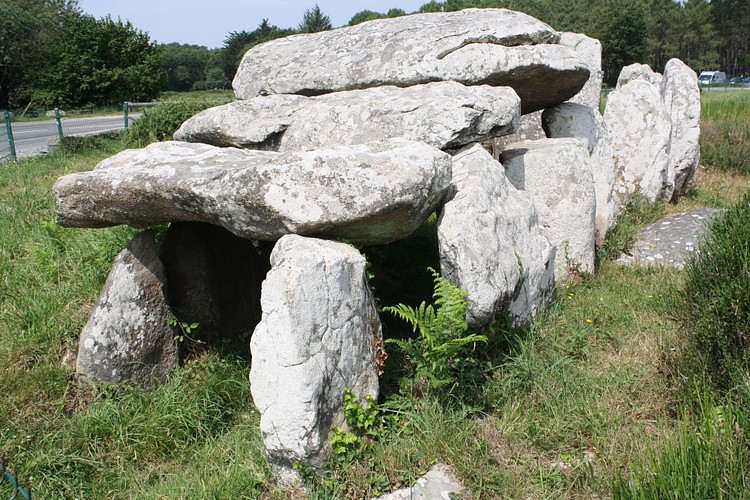
Carnac, located on the north-west coast of France, is the site of the largest concentration of megalithic monuments in the world. Over 100 monuments, which include burial mounds, stone tombs, enclosures, and linear arrangements of menhirs, were erected between the 5th and 3rd millennia BCE by the Neolithic farming communities which inhabited the area of Carnac.
ARRANGEMENTS
The granite stones (megaliths), varying in size from 1 metre in height to huge 6.5 metre tall stones weighing several hundred tons, were removed (not quarried) from rocky outcrops in the surrounding area. The stones were most probably moved using levers and rollers and those stones positioned on top of others were dragged up an artificial earth incline made level with the top of the vertical stones with the earth then being removed when the construction was complete. The stones were placed in several types of arrangements:
- Menhirs - single free-standing stones, often roughly dressed and placed within a shallow hole and on a wedge stone for stability.
- Mounds - individual tombs, also known as a tumulus.
- Dolmens - collective tombs composed of upright stones topped by horizontal stones and dry masonry, sometimes with an entrance passage and originally covered by either an earth mound preserving the access passage or a barrow with no access to the inner tombs.
- Enclosures - a circle or defined space bordered by stones and closed off by adjoining or closed megaliths.
- Alignments - parallel rows of single upright stones sometimes stretching several hundred metres. Often set in more or less straight lines but sometimes curving and even slightly changing in angle at certain points in the lines.
- Cairns - piles of smaller stones, typically built over a burial site.
KEY EXAMPLES
St. Michael's Barrow, measuring 125 x 60 metres and 12 metres high, is the largest burial mound at the site. Its name derives from the chapel built in modern times on its summit. Excavations within the inner burial chamber placed 8 metres down have revealed many artefacts now in the museum of Prehistory in Vannes. These include shell pendants, beads, more than 40 axe-heads of either green jadeite or white fibrolite, and 97 pearls. Secondary and more comprehensive excavations revealed a small dolmen at the west end of the mound and a larger tomb in the centre which was itself surrounded by 15 irregular graves containing cattle bones. Carbon dating places the construction of the barrow as early as 6,000 BCE.

Neolithic Variscite Necklace
The Kerlescan Mound has a 3.7 metre high marker stone on top, a common feature of such structures. Finds within the mound date to 2,200 BCE and include pottery and a copper axe. The Er Mané Barrow takes an unusual oval form and measures 35 x 23 metres and stands 12 metres above the surrounding area. Once again a menhir has been placed on the top, this one measuring 2.8 metres high. Yet another example of the barrow form is the Le Manio Barrow which measures 37 x 10 metres and is topped by a massive 6.5 metre menhir known as the Manio Giant. The large stones within the structure display serpent-like carvings.
Of the 50-plus dolmen scattered around Carnac the most celebrated is the Crucuno Dolmen with its classic arrangement of a circle of giant stones topped by a massive 40-ton stone slab. The dolmen's burial chamber measures 3.5 metres across and is 1.8 metres high. Originally, there was also a 24 metre long entrance corridor composed of standing stones but these, like so many of Carnac's structures, were plundered so that the stones could be re-used in modern buildings.
One of the few dolmen with its original earth mound above and still with a 6.5 metre long stretch of its entrance tunnel is the dolmen near the Kermario section of the alignments which was built c. 4,600-4,700 BCE. Measuring 25 metres in diameter and standing 5 metres tall the structure once had an impressive ring of stones around the entire circumference but only those stones on the south-west side survive. The stone slabs within the structure were carved to show geometric and axe head designs. One large stone in the inner chamber takes the form of a shield which is a feature of dolmen throughout the region and considered to represent a mother-earth goddess. Artefacts excavated from within include pottery, axes, beads and flint arrowheads, many dating to c. 2,000 BCE and illustrating that the structure was used over millennia.
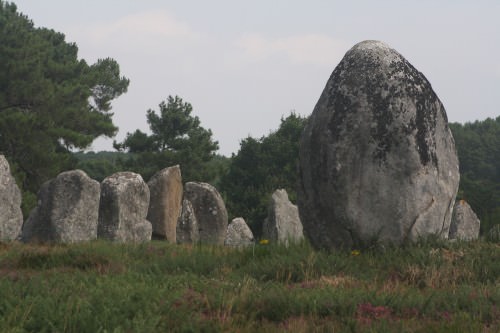
Carnac Alignments
Perhaps the best dolmen without its barrow is the one situated at the confines of the Kermario alignments. Measuring 8.7 metres in length, four of the stone slabs of the roof remain along with a short section of the entrance passage. Examples of dolmen which contain inner compartmentalised chambers are the Keriaval Dolmen which actually has two lateral chambers, at Mané Groh with its four inner chambers, and the rectangular Clud-er-Yer Dolmen. Finally, the several dolmens near the Kerlescan alignments are good examples of less common burial chambers with a secondary side entrance.
The long parallel rows and semi-circular arrangements of large upright menhirs which stretch 15 km across the fields of Carnac are known simply as the Alignments. The thousands of stones have suffered all manner of interference over the years.Some have been moved by farmers to avoid archaeologists interfering in their livelihood, many have been stolen, roads and car parks have been constructed through them, over 50 were used to build a lighthouse and not a few have fallen on their sides. Still, enough survive to create an impressive panorama of a pre-meditated scheme of placement. The most complete group is at Le Menec where there are eleven rows of stones, each stone decreasing in size moving towards the east and terminating at each end in a large stone circle. The circle at the western end was originally constructed using around 70 stones. The best surviving enclosure, though, is with the Kerlescan alignment section where there is a 240 x 200 metre space surrounded by large upright stones placed very close together. Excavations within the alignments have revealed finds of pottery, flints and hearths.
PURPOSE
The exact significance of the stones, especially the alignments, has been much debated for centuries. Local people long-regarded the megaliths as magical, Boureau Deslandes thought that they had occurred naturally following 'upheavals suffered by the Earth', and the writer Gustave Flaubert famously dismissed them as merely 'large stones'. Early scholars considered them examples of Celtic temples or assembly points for the ancient druids of Armorica or even maps of celestial bodies. One of the most picturesque theories, according to the legend of St. Cornely, was that the huge stones were a transformed army of Roman legionaries who had unwisely tried to attack the Saint.
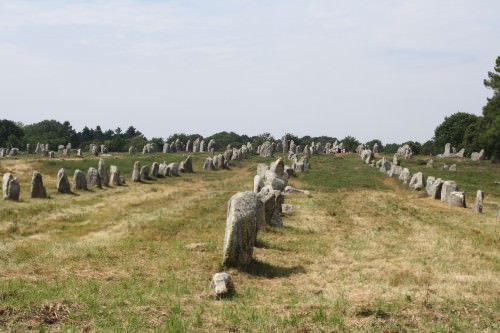
Carnac Alignments
More scientific investigation began in the 19th century CE with the Scotsman J.Miln who studied the megaliths and opened a museum of Prehistory in the small town of Carnac. Miln's work was continued by his student Zacharie Le Rouzic who also ensured the stones were protected for future generations. Their work, and that of those who followed, has shed a little more light on the secrets of Carnac.
That the larger structures are examples of ancient burial architecture seems certain but these buildings may have also served as territorial markers. The structures could also have had a secondary purpose as a symbol and reinforcement of a group identity. The single free-standing stones of the alignments are much more mysterious but scholarly consensus defines them as most probably markers pointing to or highlighting the presence of a sacred site or significant burial place. The parallel lines of stones seem to define paths which converge towards certain enclosures which are themselves situated on higher ground. It has also been noted that the lines, stretching from east to west, follow the sunrise at the solstices. Therefore, taken together - the lines and enclosures - the entire area covered by seemingly haphazard stones becomes a purposely constructed layout of processional ways and sacred spaces, a pattern reproduced by many subsequent ancient civilizations for their sacred rites from the Minoans on Crete to the Nazca in South America.
The Battle of Dun Nectain › Antique Origins
Definition and Origins
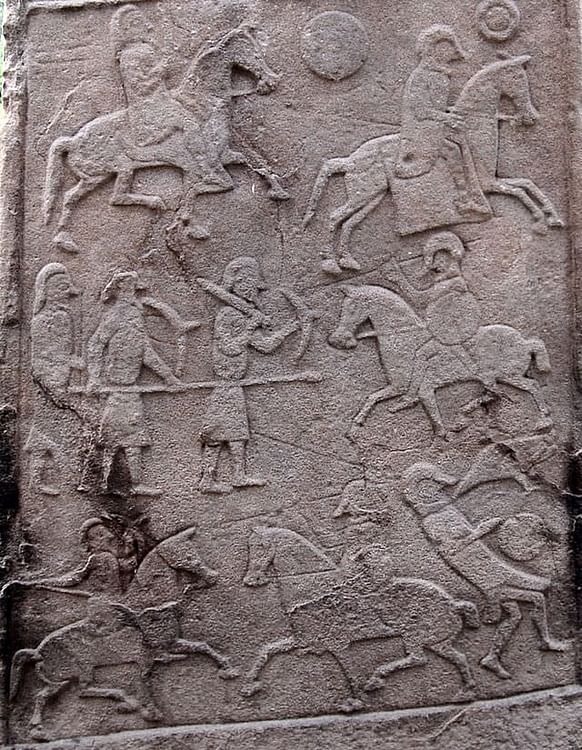
The Battle of Dun Nechtain (also known as The Battle of Dunnichen, The Battle of Nechtanemere, Lin Garan, and The Battle of Nechtan) was a pivotal engagement between the Northumbrians under their king Ecgfrith and the Picts under the leadership of their king Brude Mac Bile (also known as King Bridei III). The battle took place at 3:00 pm (15.00) on Saturday, 20 May, 685 CE. The precise dating of the engagement might suggest that there is thorough documentation of the battle but, actually, aside from the account by the historian Bede (672-735 CE) and possibly the depiction carved on the Aberlemno Stone stone #2, few details are known. The Battle of Dun Nectain stopped the Northumbrian invasions (at least for a time), freed the Scots and Britons from Northumbrian domination, and secured the boundaries of the lands of the Picts. Historians John and Julia Keay note that the battle "may thus have created the circumstances which led to the foundation of Scotland " (271). This claim is further supported by other historians, such as Stuart McHardy, who also notes the lasting importance of this battle in Scottish history.
THE BATTLE OF DUN NECHTAIN BROKE NORTHUMBRIA'S POWER AND SECURED THE BORDERS OF THE LANDS OF THE PICTS, WHICH LATER WOULD BECOME SCOTLAND.
NORTHUMBRIA & THE PICTS
The rise of the Anglican Kingdom of Northumbria, and the fall of the kingdom of Gododdin (which lay between the lands of the Picts and the southern regions of the Angles) increased Angle holdings in Britain and resulted in their regular incursions into Pictish land. The southern Picts were conquered by the Angles and subjugated, as the Scots and Britons had been before them. According to the historians Keay, "By a combination of dynastic, political, and military means, Northumbria came to dominate a large part of southern Pictland. Around 672, following the death of the powerful Northumbrian King Oswin, the Picts attempted to 'throw off the yoke of slavery' but suffered a horrendous defeat at the hands of Oswald's successor Ecgfrith" (271). Ecgfrith then instituted policies to keep the conquered peoples in their place and demanded tribute be paid regularly to the Northumbrian kingdom of Bernicia.
Northumbria had the resources and manpower to take large portions of land from tribes such as the Scots, who had arrived from Ireland and settled in Dalriada and Argyll, and the Britons of Strathclyde, both of whom, as noted, were then subjects of the Angles. One of Ecgfrith's policies was installing kings in certain territories whom he felt would serve his purpose. One of these Pictish kings was Bridei Mac Billi (better known as Brude Mac Bile), who is considered one of the greatest, if not the greatest, of the Pictish kings for halting the advance of the Angles of Northumbria and freeing his lands of their influence. In doing so, he would also remove the Northumbrian yoke from the Britons and the Scots to the south, as well as other tribes, and more or less set the early boundaries of what would later become England, Scotland, and Wales.
THE BATTLE
King Ecgfrith, who was Brude's cousin, may have helped him to power on the condition that Brude would regularly send tribute and would work for Ecgfrith's interests. This claim has been contested, however, and it is also thought that Brude came to power after the Northumbrians defeated the king of the Northern Picts, Drest Mac Donuel, at the Battle of Two Rivers in 670 CE. However Brude came to power, it is clear that he was expected to send tribute south to Northumbria. Brude, however, had no intention of doing so and, although it seems he initially did send tribute in the form of cattle and grain, this practice ended soon after he had consolidated his power. Ecgfrith was hardly pleased with this development but became more upset by Pictish raids into his kingdom south of Hadrian 's now crumbling and undefended wall. Ecgfrith decided it was time to remove Brude and teach the Picts an important lesson.
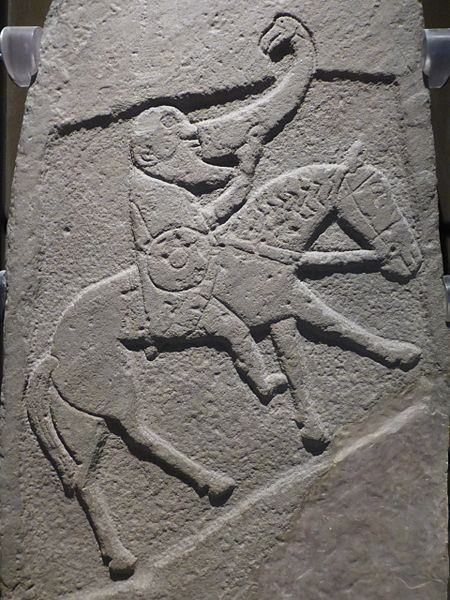
Pictish Warrior with Drinking Horn
At the same time, Brude was further consolidating his power by subduing rebellious Pictish sub-chiefs. In 681 CE he took the stronghold of Dunottar, and by 682 CE he had a navy of adequate size and strength to sail to Orkney and subdue the tribes there. Following this victory, he took the Scots' capital of Dunadd to the west so that, by 683 CE, he had secured his northern, eastern, and western boundaries (Orkney, Dunnotar, and Dunadd) and only had to concern himself with an attack directly from the south.
This attack came in May of 685 CE when Ecgfrith could no longer tolerate Brude's threats to his rule and refused the counsel of his advisors to try further diplomatic measures. He mobilized a force of cavalry (possibly numbering around 300) to put down what he saw as a Pictish rebellion in his lands. The Picts under Brude lured the Angle force deeper and deeper into their territory by feigning retreat. The Keays observe that "it would appear Brude had a plan which involved avoiding the type of ground that had led to the previous defeat [in 672] and necessitated enticing the Northumbrian army into his choice of territory. He used the local topography to trap his enemy, with Dunnichen Hill and Nectan's Mire playing a crucial role" (271). Once the Angles were securely in his grasp, Brude then struck at a place known to the Scots as Dunnichen, in English chronicles as Nechtansmere, and in Welsh chronicles as Linn Garan; the Annals of Ulster refer to it as Dun Nechtain, and this is the name most commonly referenced by historians. The Angle forces found themselves between the Pictish army on the high ground of Dunnichen Hill, who are said to have numbered in the thousands, and the marshes of the lake Nectan. Ecgfrith, realizing his dangerous position, opted for a full-scale charge of his cavalry uphill to break the Picts' line in the center. Brude, however, fell back, feigning retreat, and then turned and held the line. He repulsed the charge, sending the Angles reeling in retreat back down the hill and toward the marshes; then he counter-charged. The historian Bede, who gives the most detailed account of the battle, writes:
King Ecgfrith, ignoring the advice of his friends...rashly led an army to ravage the province of the Picts. The enemy pretended to retreat, and lured the king into narrow mountain passes, where he was killed with the greater part of his forces on the twentieth of May in his fortieth year and the fifteenth of his reign. As I have said, his friends warned him against this campaign; but in the previous year he had refused to listen to the reverend father Egbert, who begged him not to attack the Irish who had done him no harm; and this was his punishment, that he now refused to listen to those who tried to save him from destruction. Henceforward the hopes and strength of the English realm began to waver and decline, for the Picts recovered their own lands that had been occupied by the English, while the Scots living in Britain and a proportion of the Britons themselves regained their freedom. Many of the English at this time were killed, enslaved, or forced to flee from Pictish territory (Chapter 26).
AFTERMATH
The Battle of Dun Nechtain broke Northumbria's power and secured the borders of the lands of the Picts, which later would become Scotland. It also drove the Christian missionaries of the Angles ( Roman Catholicism) out of Pictish lands, allowing the original Columban brand of Christianity (the Celtic Church) to take hold in the highlands instead of the Roman brand, which had been accepted by the Angles. Brude continued to rule until his death in 693 CE, by which time his kingdom was secure and at peace.
This peace would not last long, however, as his later successor, Nechtan Mac Derile (706-724 CE), would open negotiations with the Angles on religious matters and begin a ten-year religious conflict in the kingdom between those who favored the Celtic Church and those who believed in the teachings of the Roman Catholic brand of Christianity. In spite of these conflicts, however, Brude Mac Derile had forged a unified nation which would be brought back together under the reign of King Oengus son of Uurguist in 734 CE. Oengus, and those who came after him, would repeatedly have to deal with Angle attempts to invade and conquer the land of the Picts, and this paradigm would continue through the reign of Kenneth Mac Alpin (843-858 CE) and on past the last king of the Picts, Giric, who died in 899 CE. The wars between the Angles (later the English) and the Picts (who merged with the Scots) are legendary in history and continued for centuries, but the Battle of Dun Nechtain in 685 CE established the later boundaries the two peoples would fight over and set the stage for the establishment of Scotland.
LICENSE:
Article based on information obtained from these sources:with permission from the Website Ancient History Encyclopedia
Content is available under License Creative Commons: Attribution-NonCommercial-ShareAlike 3.0 Unported. CC-BY-NC-SA License